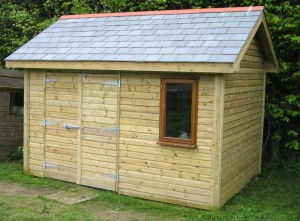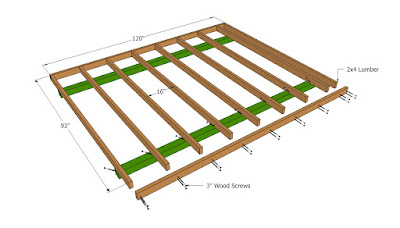A good foundation can be the difference between a maintenance free, “build it and forget it” storage shed, and one that… isn’t. Just like a good, solid breakfast is the best way to start your day, putting down a solid foundation is the best way to start building your storage shed. Why do you need a foundation? It keeps the shed level, preventing or minimizing sags or leans in the frame as the ground settles over time, which can be the difference between a shed that’s still a shed in 10 years, and not a pile of lumber in your backyard, collapsed on top of all your stuff. The foundation also protects the shed (AND the stuff inside it) from moisture in the ground, allowing water to drain through your yard naturally, without pooling inside your shed.
There are three main types of shed foundations, and your choice depends on the type of shed you want to build, your landscaping / the grade of your backyard, and your local climate. Here’s a quick overview of the three most popular shed foundations, and reasons why each might be right for you.
Sleeping or Skid Foundation
So called because the shed is supported by wooden “sleepers” or skids. For pioneers, the sleepers were nothing more than logs laid on the ground (“sleeping,” get it?). Nowadays, they’re usually pressure treated 4×4, 4×6, 6×6, or 8×8 timbers, cut to the necessary length.This setup is low cost, and easy to plan, setup, and lay out, making it the foundation of choice for wooden outhouses from pioneer times to the modern day. But, it comes with a few requirements, the ground needs to be level (or graded level) to keep your shed from sagging, slumping, leaning, or sliding away, and for optimal drainage (and sleeper life expectancy) you should put down a bed of gravel one inch to two inches deep. The simplest and quickest way is to dig out a shallow pit, only about two inches deep, easy enough to do with nothing more than a garden spade, with dimensions slightly larger than your shed’s footprint, and fill the area with crushed rock or gravel.
If you want to fancy it up a bit, you can edge your dugout with 1×4 or 1×6 boards, this will help contain the gravel, and keep stones from settling out into your yard (and getting caught up by your lawnmower).
Floating Foundation
Floating foundations are easy to build, and with a bit of planning and the right materials, can provide a lifetime of support for your shed. The technique employed in this foundation is to “float” a wooden platform on a set of durable supports, most often concrete blocks, although metal or wood supports anchored in poured concrete can be used. The supports let water flow under the platform (versus through your shed) and allows air to circulate as well, so that the soil dries quickly, and the risk of mildew is reduced.One advantage of the floating foundation is that it can be easily adjusted to graded terrain. If you want or need to build your sled on a slope, rather than excavating a big pile of dirt, and potentially changing the drainage in your backyard, you can lay down a floating foundation for your shed, and adjust the height of your supports as needed to ensure a level platform.
One last thing about a floating foundation, unless you live in the desert, you’ll probably want to mimic the sleeping foundation and put a one to two inch bed of gravel underneath each concrete block. The gravel will improve drainage and reduce soil erosion, which left unchecked could lead to a leaning shed
Slab Foundation
The slab foundation is the mother of all foundations as far as durability is concerned. Make it the right way and it will be as weatherproof and long lasting as a well made basement. The price for that long life is more up front work, as excavating the earth, building your mold, pouring and casting your concrete, all requires significantly more planning, equipment, and elbow grease than sleeping or floating foundations.The thickness of your concrete slab can vary from two inches to six inches, it depends on your climate and the load you want it to carry (the size and weight of your shed, and what your shed is going to hold.
The basic approach is to dig out a six to twelve inch bed in your topsoil, and then build a wooden form for your poured concrete. There are several popular form techniques, but the common denominators are leveling and squaring the form, ensuring the supports are adequate to hold the weight of the poured concrete, and coating the inside of your form with a commercial release agent so the concrete doesn’t stick to your form. Next, fill the area with four to six inches of gravel, wet it down with the garden hose, and tamp it with a hand or power tamper. You might want to put a vapor barrier on top of the gravel, to help keep moisture from seeping up into the concrete. For most sheds, you’ll probably need more than two yards of concrete, which is best delivered pre mixed and ready to pour from a local contractor or concrete supplier. Pour the concrete into your form, spread with a rake, level with a long 2×4 board, and finish it with trowels and concrete planers.
Easy, right? As I said, it’s a lot of work, but the end result is an awesome foundation that should be able to take anything you, or mother nature, throws at it (and if you really want sick structural support, you can reinforce your concrete with iron rebar, but that’s an article for another day).
One other thing you might not have considered, if you plan to hose down garden equipment or other tools in your shed, or use hot solder, welding or brazing tools, then a slab foundation is the only safe choice.
Of course, details matter, and I haven’t discussed what rocks work best for gravel, or where in the yard to place your shed, regardless of the foundation. A good set of shed plans will take you through all of these issues, and ensure you’ve got the best support system in place for your shed, the items you’re storing inside, and your local climate.
Search
Information You Can Build a Beautiful Shed.
If you wish to make use of extra space on yard for storage or a work area, a DIY learn to shed will surely provide you exactly which you ne...

Popular Posts
-
A fireplace may be a rattling comfort to possess on wet and cold winter days. Look the flames flicker are often an awfully soothing expertis...
-
Building a great wood shed often requires the use of wood shed plans . Many people seeking to build new wood sheds often find it difficult t...
-
If you’re planning on constructing a garden or outdoor storage shed you’ll need some kind of strategy. It doesn’t make a difference if y...
-
Great News! We have recently come across an excellent set of wood shed plans that’s available to download and has detailed instructions and...
-
The outside devices and toys are heaping up in the carport and need another home. In the wake of considering your choices the victor is to c...
-
If you are thinking of building a shed , then you need a shed blueprint. Most people don’t know the advantages of having a shed blueprint. ...
-
When constructing storage sheds, more often than not, there seems to be several options facing an enthusiast of Do It Yourself. There is t...
-
There are many different types of garden shed plans available on the internet these days. It seems like just about anyone who has tried the...
-
A homemade greenhouse can yield year around and produce for a family of four here are the advantages to owning a greenhouse and some tips ...
-
12×16 Shed Plans - Essential Tips For Building Your Own Shed If уου аrе looking fοr shed plans 12 x 16 , thе fastest way іѕ online tο mа...
 Filed Under :
Filed Under :
 11:23 PM
11:23 PM
 Tags :
Tags :










0 Response to “Sleeping, floating, or slab - Which shed foundation is right for you?”
Leave a Reply